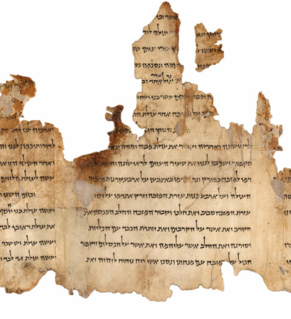See also
| This disambiguation page lists articles associated with the title Ancient Hebrew language. If an internal link led you here, you may wish to change the link to point directly to the intended article. |
Ancient Hebrew (ISO 639-3 code hbo is a blanket term for pre-modern varieties of the Hebrew language:
| This disambiguation page lists articles associated with the title Ancient Hebrew language. If an internal link led you here, you may wish to change the link to point directly to the intended article. |
The ancient Aramaic alphabet was adapted by Arameans from the Phoenician alphabet and became a distinct script by the 8th century BC. It was used to write the Aramaic language and had displaced the Paleo-Hebrew alphabet, itself a derivative of the Phoenician alphabet, for the writing of Hebrew. The letters all represent consonants, some of which are also used as matres lectionis to indicate long vowels.
Aramaic is the language or group of languages of the ancient region of Syria. It belongs to the Northwest Semitic group of the Afroasiatic language family, which also includes the Canaanite languages, such as Hebrew, Edomite, Moabite, and Phoenician, as well as Amorite and Ugaritic. The Aramaic alphabet was widely adopted for other languages and is ancestral to the Hebrew, Syriac and Arabic alphabets. During its approximately 3,100 years of written history, Aramaic has served variously as a language of administration of empires, as a language of divine worship and religious study, and as the spoken tongue of a number of Semitic peoples from the Near East.

The Bible is a collection of religious texts or scriptures sacred to Christians, Jews, Samaritans, Rastafari and others. They generally consider the Bible to be a product of divine inspiration and a record of the relationship between God and humans. The Bible appears in the form of an anthology, a compilation of texts of a variety of forms that are all linked by the belief that they collectively contain the word of God. These texts include theologically-focused historical accounts, hymns, parables, didactic letters, erotica, sermons, poetry, and prophecies.
The Hebrew alphabet, known variously by scholars as the Jewish script, square script and block script, is an abjad script used in the writing of the Hebrew language and other Jewish languages, most notably Yiddish, Judeo-Spanish, Judeo-Arabic and Judeo-Persian. It is an offshoot of the Imperial Aramaic alphabet which flourished during the Achaemenid Empire.

Hebrew is a Northwest Semitic language native to Israel. In 2013, Modern Hebrew was spoken by over nine million people worldwide. Historically, it is regarded as the language of the Israelites and their ancestors, although the language was not referred to by the name "Hebrew" in the Tanakh itself. The earliest examples of written Paleo-Hebrew date from the 10th century BCE. Hebrew belongs to the West Semitic branch of the Afroasiatic language family. Hebrew is the only Canaanite language still spoken and the only truly successful example of a revived dead language.

The Semitic languages, previously also named Syro-Arabian languages, are a branch of the Afroasiatic language family originating in the Middle East that are spoken by more than 330 million people across much of Western Asia, North Africa, the Horn of Africa, Malta, in small pockets in the Caucasus as well as in often large immigrant and expatriate communities in North America, Europe and Australasia. The terminology was first used in the 1780s by members of the Göttingen School of History, who derived the name from Shem, one of the three sons of Noah in the Book of Genesis.
Hebrews or the Hebrew people is mostly taken as synonymous with the Semitic-speaking Israelites, especially in the pre-monarchic period when they were still nomadic. However, in some instances it may also be used in a wider sense, referring to the Phoenicians, or to other ancient groups, such as the group known as Shasu of Yhw on the eve of the Bronze Age collapse, although it was not an ethnonym, It appears 34 times within 32 verses of the Hebrew Bible.

The Phoenician alphabet is an alphabet consisting of 22 consonant letters only, leaving vowel sounds implicit, although certain late varieties use matres lectionis for some vowels.
Ugaritic is an extinct dialect of the Amorite language known through the Ugaritic texts discovered by French archaeologists in 1929. It is known almost only in the Ugarit texts found in the ruined city of Ugarit. It has been used by scholars of the Hebrew Bible to clarify Biblical Hebrew texts and has revealed ways in which the cultures of ancient Israel and Judah found parallels in the neighboring cultures.

Modern Hebrew or Israeli Hebrew, generally referred to by speakers simply as Hebrew, is the standard form of the Hebrew language spoken today. Spoken since ancient times, Hebrew, a member of the Canaanite branch of the Semitic language family, was supplanted as the Jewish vernacular by the western dialect of Aramaic beginning in the third century BCE, though it continued to be used as a liturgical and literary language. It was revived as a spoken language in the 19th and 20th centuries and is the official language of Israel.

Jewish languages are the various languages and dialects that developed in Jewish communities in the diaspora. The original Jewish language is Hebrew, which was supplanted as the primary vernacular by Aramaic following the Babylonian exile. Jewish languages feature a syncretism of indigenous Hebrew and Judeo-Aramaic with the languages of the local non-Jewish population. Many Sephardic Jews upon returning to Israel brought with them Arabic. Being born in such countries as Libya, Iraq, Syria, Yemen, and Lebanon, they were native speakers of Arabic. It is common to hear Israeli Jews and Israeli Arabs having indepth conversations in both Arabic and Hebrew.
The Canaanite languages, or Canaanite dialects, are one of the three subgroups of the Northwest Semitic languages, the others being Aramaic and Ugaritic. They include Hebrew, Phoenician/Carthaginian, Amorite, Ammonite, Ekronite, Moabite and Edomite which were all mutually intelligible, being no more differentiated than geographical varieties of Modern English.

Mishnaic Hebrew is a form of the Hebrew language that is found in the Talmud. The forms of the Hebrew in the Talmud can be divided into Classical Hebrew for direct quotations from the Hebrew Bible, and Mishnaic Hebrew can be further sub-divided into Mishnaic Hebrew proper, which was a spoken language, and Amoraic Hebrew, which was a literary language only.

The Paleo-Hebrew script, also spelled Palaeo-Hebrew, also known as Proto-Hebrew or Old Hebrew, was the script used in the historic kingdoms of Israel and Judah, specifically to record the Ancient Hebrew language, including the texts of the Hebrew Bible in its original script. Old Hebrew, like the Phoenician alphabet, is a slight regional variant and an immediate continuation of the Proto-Canaanite script, which was used throughout Canaan in the Late Bronze Age. Hebrew is attested epigraphically from about the 10th century BCE, and no extant "Phoenician" inscription is older than 1000 BCE. The Phoenician language, Hebrew language, and all of their sister Canaanite languages were largely indistinguishable dialects before that time. The Paleo-Hebrew alphabet is an abjad of 22 consonantal letters. Use of the term "Paleo-Hebrew alphabet" is due to a 1954 suggestion by Solomon Birnbaum, who argued that "[t]o apply the term Phoenician to the script of the Hebrews is hardly suitable".

Hebrew literature consists of ancient, medieval, and modern writings in the Hebrew language. It is one of the primary forms of Jewish literature, though there have been cases of literature written in Hebrew by non-Jews. Hebrew literature was produced in many different parts of the world throughout the medieval and modern eras, while contemporary Hebrew literature is largely Israeli literature. In 1966, Agnon won the Nobel Prize for Literature for novels and short stories that employ a unique blend of biblical, Talmudic and modern Hebrew, making him the first Hebrew writer to receive this award.
A Hebraist is a specialist in Jewish, Hebrew and Hebraic studies. Specifically, British and German scholars of the 18th and 19th centuries who were involved in the study of Hebrew language and literature were commonly known by this designation, at a time when Hebrew was little understood outside practicing Jewish communities.
In a right-to-left, top-to-bottom script, writing starts from the right of the page and continues to the left. This can be contrasted against left-to-right writing systems, where writing starts from the left of the page and continues to the right.
Northwest Semitic is a division of the Semitic languages comprising the indigenous languages of the Levant. It would have emerged from Common Semitic in the Early Bronze Age. It is first attested in proper names identified as Amorite in the Middle Bronze Age. The oldest coherent texts are in Ugaritic, dating to the Late Bronze Age, which by the time of the Bronze Age collapse are joined by Old Aramaic, and by the Iron Age by the Canaanite languages.

The Hebrew alphabet is a development from the Aramaic alphabet taking place during the Persian, Hellenistic and Roman periods. It replaced the so-called Paleo-Hebrew alphabet which was used in the earliest epigraphic records of the Hebrew language.

Jews or Jewish people are an ethnoreligious group and a nation, originating from the Israelites and Hebrews of historical Israel and Judah. Jewish ethnicity, nationhood, and religion are strongly interrelated, as Judaism is the ethnic religion of the Jewish people, while its observance varies from strict observance to complete nonobservance.